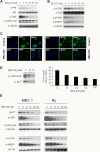Dual targeting of the PI3K/Akt/mTOR pathway as an antitumor strategy in Waldenstrom macroglobulinemia
- PMID: 19965685
- PMCID: PMC2810978
- DOI: 10.1182/blood-2009-07-235747
Dual targeting of the PI3K/Akt/mTOR pathway as an antitumor strategy in Waldenstrom macroglobulinemia
Abstract
We have previously shown clinical activity of a mammalian target of rapamycin (mTOR) complex 1 inhibitor in Waldenstrom macroglobulinemia (WM). However, 50% of patients did not respond to therapy. We therefore examined mechanisms of activation of the phosphoinositide 3-kinase (PI3K)/Akt/mTOR in WM, and mechanisms of overcoming resistance to therapy. We first demonstrated that primary WM cells show constitutive activation of the PI3K/Akt pathway, supported by decreased expression of phosphate and tensin homolog tumor suppressor gene (PTEN) at the gene and protein levels, together with constitutive activation of Akt and mTOR. We illustrated that dual targeting of the PI3K/mTOR pathway by the novel inhibitor NVP-BEZ235 showed higher cytotoxicity on WM cells compared with inhibition of the PI3K or mTOR pathways alone. In addition, NVP-BEZ235 inhibited both rictor and raptor, thus abrogating the rictor-induced Akt phosphorylation. NVP-BEZ235 also induced significant cytotoxicity in WM cells in a caspase-dependent and -independent manner, through targeting the Forkhead box transcription factors. In addition, NVP-BEZ235 targeted WM cells in the context of bone marrow microenvironment, leading to significant inhibition of migration, adhesion in vitro, and homing in vivo. These studies therefore show that dual targeting of the PI3K/mTOR pathway is a better modality of targeted therapy for tumors that harbor activation of the PI3K/mTOR signaling cascade, such as WM.
Figures







Similar articles
-
Role of dual PI3/Akt and mTOR inhibition in Waldenstrom's Macroglobulinemia.Oncotarget. 2010 Nov;1(7):578-582. doi: 10.18632/oncotarget.192. Oncotarget. 2010. PMID: 21317453 Free PMC article. Review.
-
Dual targeting of phosphoinositide 3-kinase and mammalian target of rapamycin using NVP-BEZ235 as a novel therapeutic approach in human ovarian carcinoma.Clin Cancer Res. 2011 Apr 15;17(8):2373-84. doi: 10.1158/1078-0432.CCR-10-2289. Epub 2011 Mar 3. Clin Cancer Res. 2011. PMID: 21372221 Free PMC article.
-
Genotype-dependent efficacy of a dual PI3K/mTOR inhibitor, NVP-BEZ235, and an mTOR inhibitor, RAD001, in endometrial carcinomas.PLoS One. 2012;7(5):e37431. doi: 10.1371/journal.pone.0037431. Epub 2012 May 25. PLoS One. 2012. PMID: 22662154 Free PMC article.
-
Dual phosphoinositide 3-kinase/mammalian target of rapamycin inhibitor NVP-BEZ235 has a therapeutic potential and sensitizes cisplatin in nasopharyngeal carcinoma.PLoS One. 2013;8(3):e59879. doi: 10.1371/journal.pone.0059879. Epub 2013 Mar 22. PLoS One. 2013. PMID: 23533654 Free PMC article.
-
New inhibitors of the mammalian target of rapamycin signaling pathway for cancer.Expert Opin Investig Drugs. 2010 Aug;19(8):919-30. doi: 10.1517/13543784.2010.499121. Expert Opin Investig Drugs. 2010. PMID: 20569080 Review.
Cited by
-
The dual PI3K/mTOR inhibitor NVP-BEZ235 induces tumor regression in a genetically engineered mouse model of PIK3CA wild-type colorectal cancer.PLoS One. 2011;6(9):e25132. doi: 10.1371/journal.pone.0025132. Epub 2011 Sep 26. PLoS One. 2011. PMID: 21966435 Free PMC article.
-
Role of dual PI3/Akt and mTOR inhibition in Waldenstrom's Macroglobulinemia.Oncotarget. 2010 Nov;1(7):578-582. doi: 10.18632/oncotarget.192. Oncotarget. 2010. PMID: 21317453 Free PMC article. Review.
-
Curcumin significantly enhances dual PI3K/Akt and mTOR inhibitor NVP-BEZ235-induced apoptosis in human renal carcinoma Caki cells through down-regulation of p53-dependent Bcl-2 expression and inhibition of Mcl-1 protein stability.PLoS One. 2014 Apr 17;9(4):e95588. doi: 10.1371/journal.pone.0095588. eCollection 2014. PLoS One. 2014. PMID: 24743574 Free PMC article.
-
Novel agents in Waldenström macroglobulinemia.Clin Investig (Lond). 2011;1(6):815-824. doi: 10.4155/CLI.11.60. Clin Investig (Lond). 2011. PMID: 22034589 Free PMC article.
-
Withanolides are potent novel targeted therapeutic agents against adrenocortical carcinomas.World J Surg. 2014 Jun;38(6):1343-52. doi: 10.1007/s00268-014-2532-0. World J Surg. 2014. PMID: 24763440
References
-
- Vivanco I, Sawyers CL. The phosphatidylinositol 3-kinase AKT pathway in human cancer. Nat Rev Cancer. 2002;2:489–501. - PubMed
-
- Pene F, Claessens YE, Muller O, et al. Role of the phosphatidylinositol 3-kinase/Akt and mTOR/P70S6-kinase pathways in the proliferation and apoptosis in multiple myeloma. Oncogene. 2002;21:6587–6597. - PubMed
-
- Van de Sande T, De Schrijver E, Heyns W, Verhoeven G, Swinnen JV. Role of the phosphatidylinositol 3′-kinase/PTEN/Akt kinase pathway in the overexpression of fatty acid synthase in LNCaP prostate cancer cells. Cancer Res. 2002;62:642–646. - PubMed
Publication types
MeSH terms
Substances
Grants and funding
LinkOut - more resources
Full Text Sources
Other Literature Sources
Research Materials
Miscellaneous

